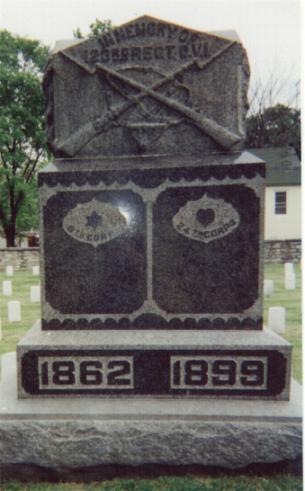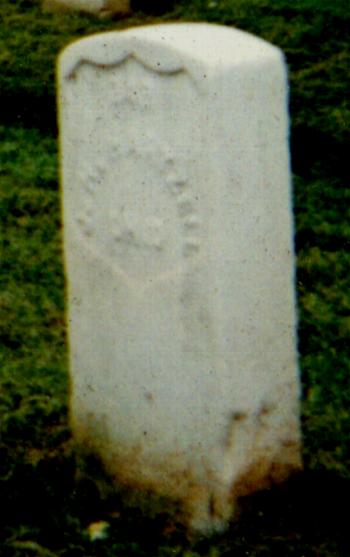The 123rd OVI
Sheridan's Shenandoah Valley Campaign
August & September, 1864
THE LAST DAYS OF JAMES HARTZELL
By Stephen
J. Hartzell


The 123rd Ohio Volunteer Infantry Monument
Winchester National Cemetery
Photo by Stephen J. Hartzell - May, 1999

Other 123rd OVI Pages
James Hartzell's Civil War Service
Record - 1862-64
Members of the 123rd OVI
Buried at Winchester National Cemetery

After the Battle at Kernstown the 123rd Ohio Volunteer Infantry, and
the Department of West Virginia was under the command of General Phil Sheridan.
From this point they become known as the Department of the Shenandoah.
The government issued much needed shoes and clothing in preparation for
the impending campaign.
Phil Sheridan, an Ohio native, was short of stature but quickly became
known as a fierce warrior who believed in "total war". Loved by his men,
he was a hard talking man who could scarcely complete a sentence without
swearing. President Lincoln, when advised by General Grant to place the
Department of the Shenandoah in Sheridan's charge, was at first hesitant
about the 33 year old Sheridan. Reluctantly though, he agreed. History
would show that this was undoubtedly the right man for the job.
Crossing the river at Harpers Ferry, the 123rd OVI encamped near Halltown
on August 8, 1864, remaining there until the 10th when they started up
the Shenandoah, arriving near Berryville at night. The next morning they
again started up the river. The day was hot, the country was wild and the
men suffered greatly from the heat. Water was in short supply. They encamped
for the night near Nineveh Church.
In the morning they turned north, eventually reaching the Valley Turnpike
at Middletown where they passed the Cavalry, which had been pushing the
Rebels down the road from Martinsburg, which was some 50 miles east. The
123rd then encamped near the road about 3 miles from Cedar Creek where
they remained for 4 days. Here they found corn in great abundance, and
they made good use of it.
On the 16th they received orders to move. Just before moving out, Regimental
Commander, Colonel Wilson became very ill from an apparent overdose of
morphine. Captain Chamberlain then took command of the regiment.
They marched to Winchester that night, and the next day to Berryville.
On the 18th they moved to the small town of Clifton and encamped. On the
20th the 123rd reported 360 men and 6 officers.
The next morning they went out as guard to a forage train. While loading
their wagons, the men heard fighting and artillery nearby. They hurried
back to camp only to find it deserted. After much searching they finally
found their place in the line of battle and went to work building a breastwork
out of rails, which they had to carry a considerable distance.
Near evening they moved out to support a battery in the front, but soon
the firing ceased. At 11:00 pm they began to move back in the direction
of Harper's Ferry and after marching about 14 miles they reached the camp.
The Brigade Commander was with them, as he had lost the rest of the Brigade
in the night. After some time escorting him around to find it he, in disgust,
finally told them to go into camp wherever they wished.
Again the following morning they heard skirmishing on the front. At
noon the 123rd was at work fortifying their position. Strongly entrenched
by nightfall the army settled in. For 3 days the skirmishing continued
along the whole line. The men remained hidden behind their works the entire
time.
Finally on the 25th the skirmishing ceased. Soon they were on easy terms
with the Rebels. They began fraternizing and trading newspapers and coffee,
for tobacco and etc. This practice of fraternizing with the enemy and trading
goods during quiet times was a fairly common one in the Civil War.
On the 27th the Rebels had abandoned their position. The 123rd was to
be in readiness to move without baggage. They were issued 3 days ration
to last 4 days. They moved out early the next day, and finally encamped
near Charlestown. They mustered on the 31st and received 4 months pay.
Among those encamped here was General George A. Custer, who would later
meet his end at Little Big Horn in the Indian Wars.
On the morning of September 3rd they moved up the valley, arriving at
Berryville at about noon. The pickets were under attack and the 123rd went
out in their support. Moving through a corn field they suddenly came upon
a brigade of Rebels. They gave them a few volleys but the charging Rebels
forced their retreat. Upon reaching their reserves they halted, and were
forced to lay on their arms all night in a cold rain. In the morning they
began building breastworks, but they never had to fire over them.
On the 7th, Colonel Kellogg took command of the regiment from Captain
Chamberlain. Kellogg had been on sick leave and was just now returning
to duty. Captain Shawhan returned to duty on the 12th. On the 15th, Colonel
Kellogg again went on "sick leave" and went to his home, giving command
back to Captain Chamberlain.
By now, Sheridan's army was in top condition. They generally felt as
though they could whip the Rebs at any time. The buzz among the soldiers
was "why don't we do it!" Finally on the 16th, General Grant visited the
army. Grant could see that Sheridan wanted permission to strike. He gave
it to him in 2 words, "GO IN!"
On the morning of September 19, 1864, the 123rd was moving in the direction
of Winchester with their Corps having the advance. They could soon hear
firing in the distance, and as they continued to advance it increased in
volume. By 10:00 they had reached the Berryville Pike at it's crossing
of Opequan Creek. The Battle had now become a deafening roar. They waited
in reserve until about 2:00, then the order came.
Crossing the Opequan Creek they made their way along a narrow woody
gorge. The gorge, crowded and choked up with debris, was slow and difficult
to move through. Finally they reached the front.
They stood before a ravine, in front of which was a narrow strip of
woods. They rapidly formed in column by brigade with the 123rd at the front.
They stood in readiness to relieve the division now heavily engaged on
the southern edge of Redbud Creek. They could see General Sheridan riding
up and down the line waving his hat, urging the men on, and spanking the
stragglers with his sword. This greatly amused and excited the men, who
were now ready, and eager to strike a blow.
The bugle sounded and they immediately charged on the doublequick. With
the 123rd at the front, the rebels were soon in rapid retreat. They drove
the Rebels over stone fences, up hills and down ravines for over 2 miles.
About 4:00, the Cavalry got on their flank at Winchester and continued
to drive them down through the valley.
In this gallant charge the 123rd lost 7 killed and 45 wounded, with
most being hit when the Rebels occasionally slowed their retreat just long
enough to return a quick volley. The Regiment won special praise from General
Thoburn for gallant conduct. The 123rd was the first regiment to move over
the Rebel fortifications and into Winchester. Much maligned at New Market,
they earned much glory at Winchester.
4 of the 7 killed were from Company D. One of the killed was our own
James
Hartzell. Based on all of the above information, it becomes reasonably
certain that James died somewhere between Redbud Creek and the city of
Winchester between 2:00 and 4:00pm.
He lay on the battlefield until 2 days later. The 123rd had counted
their losses and buried their dead. Leaving their brave fallen comrades
to the peaceful care of mother earth, they broke camp and began their march
to Strasburg


The Grave of James H. Hartzell
Winchester, Virginia

NOTE:
James Hartzell was initially buried in the Lutheran Burial Ground in
Winchester, which also served as the site of one of the field hospitals.
These graves were marked with wooden markers. That burial ground is now
part of Mt. Hebron Cemetery in Winchester, and this was where most of the
123rd dead were initially buried. He was re-interred at Winchester National
Cemetery about 2 years later, section 12; grave 343. This National
Cemetery is very near the battle ground.

Other 123rd OVI Pages
James Hartzell's Civil War Service
Record - 1862-64
Members of the 123rd OVI
Buried at Winchester National Cemetery

Return to the Seneca Hartzell History Links
EMAIL
©1998 - 2001 by Stephen J. Hartzell
All rights reserved
![]()
![]()
![]()
